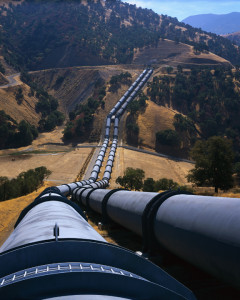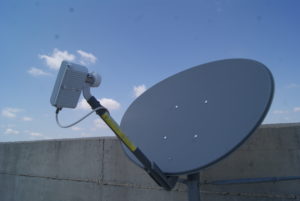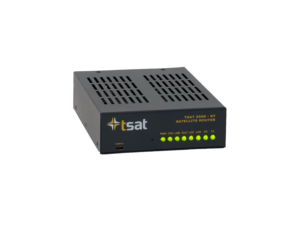
TSAT – Satellite backhaul for industrial IoT devices
TSAT is a Norwegian provider of satellite backhaul communications solutions particularly developed for remote locations. TSAT’s narrowband satellite solutions enable management of mission critical infrastructure in harsh and hard to reach locations and is the only solution on the market with a miniature VSAT HUB. The dedicated private satellite network is affordable and specifically designed for SCADA, M2M, Telemetry and IoT.
TSAT’s heritage dates back to 1995 when the first satellite solution, TSAT 2000, was introduced. Since then, TSAT have focused exclusively on developing the most advanced satellite communications networking solution (IOT, SCADA & M2M). The solutions enable management of critical infrastructure for industries operating at harsh and hard to reach remote locations.
Today, TSAT delivers narrowband satellite solutions to a range of industries. The solutions are specifically designed to handle mission critical applications such as SCADA, M2M, Telemetry and IOT.
How satellite backhaul can be a reliable solution for industrial IoT applications
Internt of Things (IoT) is a megatrend shaping the future of industrial operations. According to experts 75 billion IoT devices will be deployed by 2025 supporting a multitude of industrial IoT applications. A great number of these devices will be deployed in rural and remote areas with limited access to terrestrial connectivity for backhauling of data.
Satellite backhaul for IoT is a reliable option for industrial companies dependent on their IoT devices and applications always staying connected. When implemented as a private network a satellite backhaul solution is not connected to the internet. Compared to terrestrial backhaul solutions this significantly increase cyber security at the IoT applications. For many industrial companies cybersecurity is essential, ensuring proprietary industrial data is not shared with the general public.
Industries operating in remote locations require communications solutions that enable management of critical infrastructure
Several industries have critical business operations in harsh and hard to reach remote locations. At the same time, external pressure puts new requirements for companies to improve efficiency while reducing emissions.
 Power utility grids
Power utility grids
Regulations, policies and the UN Sustainable Development Goals challenge Power utility grids to improve their energy efficiency, reduce carbon emissions and use renewable energy sources. In order to become more sustainable, electrical power grids have to become smarter. This requires communication along the grid from power generation to power consumption. Simultaneously, power utilities expand their communications networks into rural and remote areas that require secure communications.
Satellites are the best solution to provide coverage in remote areas. The solution is less affected by the circumstances causing terrestrial communications to fail. As a result, narrowband satellite connectivity is the best solution for remote monitoring, controlling and surveillance of smart power grids.
TSAT’s solutions enable power utilities to cost-effectively and reliably connect even the most remote assets to important utility applications including M2M, Telemetry and SCADA.
 Oil & gas pipelines
Oil & gas pipelines
The global demand for oil and gas forces oil and gas exploration and production to more remote areas. At the same time, pipeline security is increasingly important. The best communication solutions for the oil and gas industry help companies become smarter and make it easier to monitor across operations.
Additionally, remote wells and pipeline sites need backup communications solutions to maintain operations in case of system failures. Satellites are not affected by the circumstances causing terrestrial communications to fail. Therefore, it is the most reliable solution to connect remote assets and data to business-critical SCADA, M2M and Telemetry applications.
If terrestrial networks are the primary communications infrastructure, oil and gas companies need a complementary satellite system. The solution should integrate or replace the terrestrial network for improved network resilience.
TSAT’s narrowband satellite solutions enable oil and gas companies to control and monitor pipelines remotely:
- Monitoring pressure, level, temperatures in real-time
- Ensure fiscal metering or custody transfer systems
- Control pumps, valves and compressors
- Quickly activate emergency shut-down systems (ESD)
- Monitor corrosion
- Detect leaks
- Monitor drilling and pipelines
- Ensure pipeline security and surveillance
- Secure access control
Water management
The world’s water resources are under pressure from increased population growth, climate changes and depleting aquifers from heavy agricultural irrigation. Rivers, dams and reservoirs, need to be automated and use SCADA controls to more efficiently operate their infrastructure. A satellite solution complements terrestrial communications solutions. It is also a reliable communication solution that increases cybersecurity and ensures uptime at a low cost.
TSAT’s narrowband satellite solution enables water management system operators to cost-effectively and reliably connect their remote assets. This enables applications such as SCADA, M2M and Telemetry to connect to devices reliably and cost-effectively so that they can:
- Monitor water pressure, level, temperatures
- Ensure on-line metering for large industrial consumers
- Control water pumps, valves and compressors
- Ensure water treatment and purification
- Detect leaks or other non-technical losses
- Control floods
- Improve water management site security and access control
- Secure access control
Environmental monitoring
Our climate is changing, and there is much discussion regarding the factors affecting this: pollution caused by man or by nature itself. Regardless of the causes, the changes have a profound impact on our lives. We experience more frequent and stronger occurrences of natural disasters such as tornados, hurricanes, hailstorms, tsunamis, earthquakes and volcanic activity. More research is needed to better predict and warn the public of further events. This task requires accurate and reliable data.
A satellite solution can enable research institutes and public safety agencies to cost-efficiently and reliably connect their remote stations and controls. Such a solution provides high-resolution data acquisition from a wide range of sensors. This includes position (GPS), temperature, pressure, strain, level, distance, speed and acceleration. This data can help control water levels in rivers, dams and reservoirs, as well as monitor and alarm for tsunamis and earthquakes.

The future of farming
The agricultural sector is a key sector in the years to come. Feeding the 9.6 billion people that the FAO predicts are going to inhabit the planet by 2050 is going to be an enormous challenge. Food productions have to increase by 70% in spite of the limited availability of arable lands, the increasing need for fresh water and climate changes impacting the seasonal events and the lifecycle of plants and animals.
One way to address these issues and increase the quality and quantity of agricultural production is using sensing technology to make farms more “intelligent” and more connected through Smart Farming.
TSAT’s satellite solutions enables smart farming by ensuring information sharing and application support such as monitoring soil health, smart irrigation and fertilization and the possibility of livestock growth and feeding.
Mobility
The future of mobility is developed through smart transportation. Applications play a critical role in this development and to provide innovative services relating to different modes of transportation and traffic management. Applications enable users to be better informed and to make safer, more coordinated and “smarter” use of transportation networks.
Smart transportation consist of systems where information and communication technologies are applied in several fields. This includes road and rail transport, infrastructure, vehicles and users, traffic management and mobility management.
Satellite solutions ensure these applications run in a reliable and efficient matter to keep the traffic safe. By enabling information sharing and applications such as traffic signage, signaling and routing and security and access controls (CCTV). The solutions can also help with level crossing protection and alert of weather conditions that potentially can have an effect on the overall traffic situation.
Critical infrastructure
Just as we all rely on critical Infrastructure, we all play a role in keeping it strong, secure, and resilient. Securing and making critical infrastructure resilient is a shared responsibility shared by national, regional, and local governments, private companies and individual citizens.
A satellite solution enables the protection of core infrastructure and smart engineering design by enabling information sharing and supporting applications such as structural monitoring, protection of critical infrastructure and security and access controls (CCTV).
TSAT’s solutions
TSAT’s narrowband satellite solutions are specifically designed to handle mission-critical applications such as SCADA, M2M and Telemetry in harsh and hard to reach remote locations.
The solutions reduce recurring costs and enable satellite bandwidth to be tailored according to actual application and use. TSAT’s flat-fee subscription model makes TSAT an affordable solution that is among the best-priced satellite solutions.
TSAT’s solutions are implemented as a private network and are therefore not connected to the internet. This reduces the possibilities of cyber-attacks and greatly improves the overall cyber security.
When you implement TSAT, critical communications to and from your remote locations are ‘piped’ directly to your control center. Without the need for a terrestrial back-haul or ‘double-hop’ connection. Completely independent from public infrastructure and the internet, TSAT provides cyber secure and reliable communications for your mission-critical applications. To further improve reliability, it is possible to install a load-sharing and geo-redundant HUB solution.
TSAT delivers narrowband satellite solutions for large and small private networks, as well as a range of antennas.

TSAT 4000 Integrated Outdoor Remote
TSAT 4000
The TSAT 4000 is a satellite solution designed from the ground up for narrowband data connectivity and IoT applications. Replacing terrestrial networks, is the optimal solution for service providers eager to explore the emerging industrial IoT market and need mission-critical infrastructure in rugged and remote locations. The TSAT 4000 narrowband satellite solution uses a Ku-band mini-HUB and a rugged terminal, supported by an intuitive Network Management System.
The Ku-band satellite networks, compared to L-band satellite systems, can handle a higher data volume, are more cost-efficient and will be the preferred solution as the market continues to develop.
The TSAT 4000 platform connects IoT sensors and devices that are geographically dispersed to related IoT applications. From one or two HUBS, a forward link carrier broadcasts information from the IoT applications to connected devices and remotes. The TSAT 4000 remotes serve as a local concentrator or gateway. They transmit sensor and device data on return links back to the HUB. The remotes can be assigned to specific terminal groups and return links. The TSAT 4000 platform supports cloud applications and can transport data from legacy sensors and devices that use serial interfaces and serial communication protocols. The TSAT 4000 platform network architecture ensures the greatest network availability.
 TSAT 3500
TSAT 3500
The TSAT 3500 platform is a complete and private networking solution capable of reaching any SCADA and M2M Telemetry site. It is compatible with both IP and legacy serial devices and operates independent from terrestrial communications systems. With the TSAT HUB placed on your premise, you control the network fully. The TSAT 3500 platform is highly scalable and suits both small and medium sized networks.
TSAT 3500 builds on TSAT 3000’s legacy. The future-proof operating system and the updated hardware ensure best in class cyber security and access controls that support mission critical applications in any remote environment onshore or offshore.
Antennas
TSAT offers a range of antennas for a fully engineered end-to-end solution to meet
our clients demanding requirements for a high availability network implementation.
- Flat Panel Antenna (FPA): The TSAT flat panel antenna (FPA) is suitable for fixed sites or portable use, where a small and inconspicuous antenna is required. The FPA includes a TSAT 4000 or TSAT 3000 remote with BUC and LNB that are embedded to provide a complete terminal solution in a single unified housing.
- Stationary antennas: TSAT offer a range of antennas for stationary and fixed site deployments. Antennas are available for Ku- and C-band operation
- Auto deploy antennas: TSAT offers auto deploy antennas for mobile/temporary use-cases such as disaster response where the communications link needs to be activated within minutes on arriving on site. The antenna is usually mounted on a trailer or vehicle
- Stabilized antennas: TSAT offers compatible stabilized antennas for maritime and offshore installations where stationary antennas can not be used
- Snow and ice protection: TSAT offer passive and active snow and ice protection solutions for stationary/fixed site antenna installations.